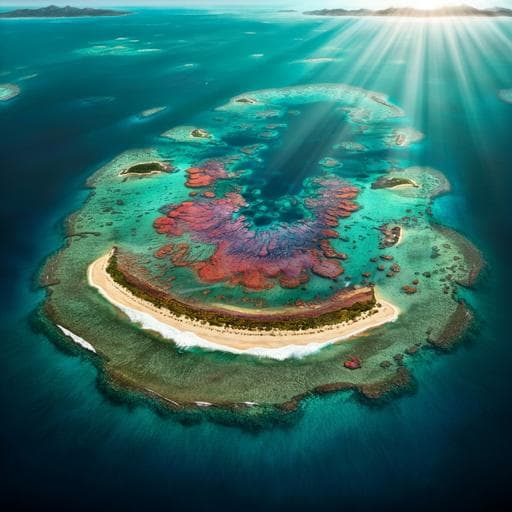
Earth Sciences
Reef islands have continually adjusted to environmental change over the past two millennia
P. S. Kench, C. Liang, et al.
Discover how global environmental changes have influenced coral reef islands over the past centuries in a groundbreaking study by P. S. Kench and colleagues. This research employs advanced radiometric dating and remote sensing to unveil the dynamic transformations of a Maldivian reef island, revealing insights crucial for future adaptation strategies.
~3 min • Beginner • English
Introduction
Low-lying coral reef islands are considered highly vulnerable to global climate change, including sea-level rise and changes in storm and wave regimes. While many recent studies have documented multi-decadal shoreline changes, there is an implicit and largely untested assumption that islands were relatively stable in pre-industrial times. This study asks whether the recent (past half-century) changes observed on reef islands are unusual or unprecedented in the context of their millennial histories, and whether the amplitude of contemporary changes exceeds historical variability. Addressing this knowledge gap is essential for robust adaptation and land-use planning in atoll nations. The authors bridge decadal to millennial timescales by integrating geological indicators (beachrock), radiometric dating of island and platform sediments, and remote sensing analyses for a data-rich case study island (Kandahalagalaa, Huvadhoo Atoll, Maldives). The purpose is to contextualize recent changes within longer-term dynamics to inform adaptation strategies relevant to human security.
Literature Review
Multi-decadal analyses based on remote sensing have quantified planform changes for over 1,100 reef islands, predominantly in the Pacific with some Indian Ocean coverage. Key observations include: most islands exhibit physical change over recent decades; expansion is the dominant response (>53% of islands), contraction occurs on <34%, and total loss is rare (~0.3% and limited to small, uninhabited islands). However, these studies have struggled to isolate climatic drivers due to strong local-scale process controls, and most assume constant island geomorphology in models. Holocene evolutionary studies using radiometric dating show islands formed at varying sea levels and timeframes, including both episodic and continuous accretion histories across different provinces (e.g., Maldives, Tuvalu, Marshall Islands, Torres Strait). Prior work often treats the present island footprint as an end point, potentially obscuring centennial-scale dynamism, and few studies possess sufficient stratigraphic and chronological resolution to resolve medium-term changes. Thus, a gap remains in linking millennial-scale formation with decadal observations to assess whether recent changes are exceptional.
Methodology
The study employs a multi-temporal, multi-method approach on Kandahalagalaa Island (Huvadhoo Atoll, Maldives) to reconstruct dynamics across millennial, centennial, and multi-decadal timescales.
- Topographic and geomorphic surveys: Reef platform and island topography were surveyed along multiple transects using a laser level and reduced to mean sea level using the Gan tide gauge. Island morphology includes five low-amplitude ridges with elevations ~1.39–1.56 m MSL north–south and up to 1.9 m MSL on the eastern ridge.
- Subsurface stratigraphy and radiometric dating (millennial scale): 20 island cores (154 sediment samples) were analyzed for skeletal composition and texture. Stratigraphy was constrained by 27 radiometric ages from island materials (23 Halimeda, 3 bulk sand, 1 coral stick). Three additional percussion cores from the reef edge and nearshore moat provided contextual platform chronology with 5 further ages. Ages were calibrated using OxCal v4.4 with Marine20 and Delta-R (-46, 51). Sediment grain sizes and component percentages were quantified to interpret depositional environments.
- Beachrock analysis (centennial to millennial scale): Eight conspicuous lithified beachrock outcrops on the northern and eastern shores were mapped for planform orientation (strike), slope (dip), elevation relative to MSL, and exposure direction, serving as paleo-shoreline indicators. Small cores were drilled to assess fabric; 11 radiometric ages on bulk sand matrices provide earliest possible formation times for the outcrops.
- Remote sensing and shoreline change (multi-decadal scale): Sequential aerial and satellite imagery (1969–2021) delineated vegetated shorelines and planform changes. Shoreline change metrics were computed using DSAS across 818 shore-perpendicular transects, yielding Net Shoreline Movement (NSM) and Shoreline Change Envelope (SCE). The island’s planform footprint, stable core area, and total change envelope were quantified. Wave climate and sea-level context (including monsoonal variability, IOD/ENSO influences, and regional sea-level trends of 3.46 ± 0.25 mm/yr since 1987) were compiled to interpret drivers.
Key Findings
- Millennial-scale formation and adjustment: Kandahalagalaa formed over an infilled shallow lagoon (faro) catching up to sea level in the late Holocene. Lagoon infill ages: ~2963 cal yBP (outer reef Porites), ~2836–2433 cal yBP (northern lagoon sediments); southern moat infill later (~1222 cal yBP). Island sediment ages (n=24) range 1889–332 cal yBP, indicating major sediment generation beginning ~1800 yBP, with primary island emergence above MSL ~1500–1000 yBP and expansion continuing to ~300–500 yBP. Widespread age inversions in most cores indicate substantial reworking and positional mobility; the vegetated island likely established above sea level within the last millennium.
- Centennial-scale paleo-shorelines (beachrock): Outcrops 1–5 date to ~1130–1440 cal yBP with orientations indicating historical eastward expansion and island position relative to outcrops; beachrock 3 (shore-parallel) dates ~1414–1366 cal yBP. Outcrops 7 and 8, detached and offshore, date ~562 and 529 cal yBP and have subtidal elevations (-0.56 and -0.36 m MSL; mean >0.75 m below MSL), implying formation at lower sea level. Beachrock 6 (oblique, central north) dates ~538 cal yBP with NW-facing beach slope. Collectively, beachrock positions and ages indicate shoreline positional shifts of approximately ±150 m horizontally and ~60 m offshore over centuries.
- Multi-decadal shoreline change (1969–2021): The island experienced strong spatial variability—substantial erosion at the northeastern shoreline and eastern tip (SCE up to ~44 m; mean NSM about -34.5 m in the NE), pronounced accretion at the northwest (max SCE 68.7 m; NSM up to 44.3 m; mean SCE ~48.2 m and NSM ~32.6 m), and consistent accretion along the southern shoreline (NSM ~9.1 m; SCE ~17.2 m). One central northern sector near beachrock 6 remained remarkably stable (NSM <1 m; SCE ~5.9 m), indicating a potential rotational fulcrum. Island-wide, 23.1% of transects eroded, 53.7% accreted, and 23.2% were stable; mean SCE ~25.2 m and overall NSM ~2.4 m. Despite reorganization, vegetated area increased by ~2360 m² (~4.4% of 1969 area). The planform change envelope encompassed 68,199 m² (26% larger than the 1969 footprint). The stable vegetated core over the half-century is ~44,604 m² (~80% of the 1969 area), while the area occupied by the island at any time was ~150% greater than the stable core.
- Long-term mobility bounds: The inner moat (117,000 m²) provides a paleo-boundary of island migration, >200% larger than the current island area. The shoreline is currently within ~100 m of this moat boundary around the island.
- Drivers: Beachrock subtidal elevations and ages align with regional sea-level lowstands (~0.8–0.9 m below present) during the Late Antique Little Ice Age and Little Ice Age (400–200 yBP). The ~500–400 yBP lowstand coincides with the ages of offshore beachrocks 7–8; subsequent sea-level rise over the last ~200 years likely remobilized sediments, promoting southward shoreline displacement. Ongoing sea-level rise (~3.46 ± 0.25 mm/yr) may sustain mobility at rates comparable to recent decades.
Discussion
The multi-temporal evidence demonstrates that Kandahalagalaa has been physically dynamic since formation, with changes in position, size, shape, and beach levels driven by environmental boundary conditions. Crucially, the magnitude of recent multi-decadal shoreline changes is not unprecedented relative to centennial–millennial variability. Beachrock chronostratigraphy indicates positional shifts of ±150–200 m since emergence ~1400 yBP, exceeding the multi-decadal SCE values (up to ~70 m) observed since 1969. The persistent stability of the central northern shoreline near beachrock 6 and core 13 suggests a long-standing fulcrum around which the island rotates, with significant sediment fluxes around it. The alignment of offshore, subtidal beachrock ages with known regional sea-level lowstands suggests that sea-level variability and associated wave/climate changes have been key drivers of island mobility, with recent sea-level rise remobilizing unconsolidated materials and driving southward migration and reorganization. These findings show that islands can maintain or increase land area even during periods of sea-level rise, and underscore the importance of distinguishing stable versus mobile sectors of islands for adaptation planning. The study provides historical context to recent observations, indicating that contemporary changes are part of ongoing, longer-term adjustments rather than uniquely Anthropocene phenomena at this site.
Conclusion
By integrating geological indicators, radiometric chronology, and remote sensing over millennial to decadal scales, the study shows that recent physical changes on Kandahalagalaa are not unprecedented. Since formation approximately 1400–1500 years ago, the island has undergone large positional shifts (±150–200 m), reworking of sediments, and planform reconfiguration, while in the last half-century it experienced substantial but spatially heterogeneous shoreline change with a net increase in vegetated area. The results emphasize the value of multi-temporal analyses to inform adaptation strategies, highlighting the need to identify and manage both stable and mobile island sectors and to account for natural oscillations in sea level and wave climate. Future research should develop comparable datasets for other islands, refine quantification of climatic drivers (e.g., IOD/ENSO impacts on nearshore processes), and integrate multi-temporal landform dynamics into adaptation and planning frameworks.
Limitations
- The primary case study focuses on a single island; generalization to other settings requires additional sites with similarly rich datasets.
- Beachrock radiometric ages on bulk sand provide earliest possible formation ages and may not date cementation precisely, introducing uncertainty in timing.
- While sea-level variability is implicated as a key driver, direct attribution of specific shoreline changes to particular climatic modes (e.g., IOD, ENSO) remains unresolved.
- Remote sensing analyses are limited to available imagery (1969–2021), and shoreline proxies (vegetated line) may lag geomorphic change.
- Despite extensive coring, age inversions and reworking complicate exact reconstruction of depositional sequences and initial island extent.
Related Publications
Explore these studies to deepen your understanding of the subject.







